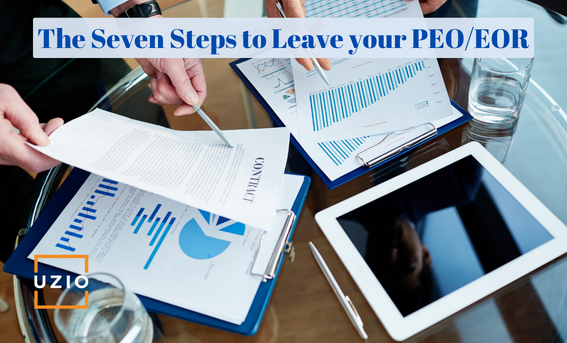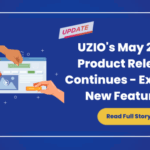
The Seven Steps to Leave your PEO/EOR
Quick links
-
Introduction
-
Why companies choose to leave their PEO/EOR providers
-
Brief overview of the steps
-
Step 1: Assess current situation and identify areas of dissatisfaction
-
Step 2: Determine future HR and payroll needs
-
Step 3: Evaluate potential solutions
-
Step 4: Select the best solution
-
Step 5: Negotiate favorable terms with the new provider
-
Step 6: Develop a detailed transition plan
-
Step 7: Implement the new solution
-
Conclusion
Introduction
A Professional Employer Organization (PEO) or Employer of Record (EOR) is a third-party company that provides outsourced human resource, payroll, and benefits services to other businesses. These organizations can help smaller companies gain access to benefits, manage payroll, and handle HR compliance issues that may be difficult to navigate on their own.
Why companies choose to leave their PEO/EOR providers
While PEO/EOR providers offer many benefits to companies, some businesses may choose to leave their provider for various reasons. These reasons may include dissatisfaction with the level of service, high costs, or the need for more customized solutions.
If you’re looking to transition away from your PEO/EOR provider, it’s important to follow a set of steps to ensure a smooth and successful transition. These seven steps include assessing the current situation, determining future HR and payroll needs, evaluating potential solutions, selecting the best solution, negotiating favorable terms with the new provider, developing a detailed transition plan, and implementing the new solution.
Following these steps can help your business make a successful transition away from your current PEO/EOR provider. It can also ensure that your new solution meets your business’s specific HR and payroll needs.
Brief overview of the steps
Each step of “The Seven Steps to Leave your PEO/EOR” is important in its own right. Assessing the current situation allows you to identify areas of dissatisfaction that need improvement, while determining future HR and payroll needs ensures that your new solution is customized to your specific needs. Evaluating potential solutions helps you compare different options and select the best one for your business. Negotiating favorable terms with the new provider can help you save money and get the most out of your new solution. Developing a detailed transition plan is critical to ensure a smooth transition, while implementing the new solution can be challenging, but ultimately rewarding.
Step 1: Assess current situation and identify areas of dissatisfaction
Before transitioning away from your current PEO/EOR provider, it’s important to identify the areas of dissatisfaction that led to the decision to leave. This can help you avoid the same issues in the future and ensure that your new solution meets your specific needs.
How to assess the current situation
To assess the current situation, it’s important to review your existing contract, talk to employees and other stakeholders, and evaluate the level of service you’re receiving.
Examples of common areas of dissatisfaction
Some common areas of dissatisfaction include limited customization options, high costs, and lack of transparency.
Step 2. Determine future HR and payroll needs
It’s important to accurately identify your future HR and payroll needs to ensure that your new solution is customized to your business’s specific needs.
How to accurately identify future needs
To accurately identify future needs, it’s important to conduct a thorough analysis of your business’s HR and payroll needs, consider the needs of your employees, and factor in any future growth or changes.
Examples of common future HR and payroll needs
Common future HR and payroll needs include more robust reporting, better benefits options, and streamlined payroll processes.
Step 3: Evaluate potential solutions
Once you have identified your company’s future HR and payroll needs, the next step is to evaluate potential solutions that can meet those needs. There is a range of potential solutions available, such as cloud-based payroll management software, payroll software for small businesses, and HR platforms.
Which factors to consider while evaluating
When evaluating potential solutions, it’s essential to consider factors such as the features and functionality of the solution, its scalability, and its ability to integrate with your existing systems. Additionally, it’s crucial to consider the cost of each potential solution, both in terms of initial investment and ongoing costs.
How to evaluate?
One way to evaluate potential solutions is to create a list of must-haves, should-haves, and nice-to-haves, based on your company’s needs. This will help you prioritize features and functionality when evaluating potential solutions and ensure that you select a solution that meets your most critical needs.
Examples of common solutions
It includes cloud-based payroll management software (like for e.g. UZIO), which allows companies to manage their payroll and HR functions in one place, and HR platforms, which provide a comprehensive solution for managing all aspects of HR, from recruiting to benefits administration.
Step 4: Select the best solution
After evaluating potential solutions, the next step is to select the best solution for your company. This involves a comprehensive evaluation process, taking into account various factors such as functionality, scalability, cost, and implementation time.
To make the best selection, it’s essential to involve key stakeholders in the decision-making process, such as HR, payroll, and finance teams. Additionally, it’s important to consider the long-term implications of your decision, such as the ability of the solution to scale as your company grows.
Examples of how to make the best selection include creating a scorecard that weighs the importance of each factor, involving a third-party consultant, and conducting demos or trials of potential solutions.
Step 5: Negotiate favorable terms with the new provider
Once you have selected the best solution, the next step is to negotiate favorable terms with the new provider. This includes negotiating the cost of the solution, as well as any additional terms and conditions, such as service level agreements, data security, and termination clauses.
Negotiation skills are essential in this step, as they can help you secure the best possible deal with the new provider. Examples of common terms to negotiate include the pricing structure, contract length, and support and maintenance services.
Step 6: Develop a detailed transition plan
The step in leaving your PEO/EOR provider is to develop a detailed transition plan. This is where the rubber meets the road, and it’s crucial to get it right. The transition plan should outline the steps that need to be taken to implement the new solution, including the timeline, resource allocation, and milestones.
A detailed transition plan can help to minimize disruption to your business operations and ensure that the transition is as smooth as possible. It can also help to identify potential risks and mitigate them before they become major issues.
To develop a comprehensive transition plan, you should work with your new provider to understand their process and requirements. You should also involve key stakeholders in the planning process, including HR, finance, and IT.
Examples of common transition plan elements include:
- Establishing a project team and assigning roles and responsibilities
- Defining the timeline and milestones for the transition
- Identifying any potential risks and developing mitigation strategies
- Establishing communication protocols and channels for all stakeholders
- Ensuring that all data is accurately transferred and integrated into the new solution
- Testing and verifying the new solution before going live
- Providing training and support to all employees who will be using the new solution
Step 7: Implement the new solution
The final step in leaving your PEO/EOR provider is to implement the new solution. This is where you put your plan into action and start to see the benefits of your hard work.
The implementation process can be challenging, and it’s essential to approach it with care and attention to detail. You should follow the transition plan that you developed in the previous step and work closely with your new provider to ensure that everything is set up correctly.
Examples of common challenges during implementation include:
- Data migration issues
- Integration challenges with other systems and software
- Employee resistance to change
- Technical glitches and bugs
- Delays in implementation due to unforeseen circumstances
It’s important to approach these challenges with a positive attitude and a problem-solving mindset. By working closely with your new provider and keeping all stakeholders informed, you can overcome these challenges and successfully implement the new solution.
Recommended Reading: Biggest pain point with Payroll and HR software
Conclusion
In conclusion, leaving your PEO/EOR provider is a major decision that requires careful consideration and planning. By following the seven steps outlined in this article, you can ensure a smooth transition and improve your HR and payroll operations.
It’s essential to follow these steps in order and to involve key stakeholders throughout the process. By doing so, you can mitigate potential risks, minimize disruption to your business operations, and improve your overall HR and payroll operations.
Leaving your PEO/EOR provider can also offer several benefits, including more control over your HR and payroll operations, cost savings, and improved flexibility. If you’re considering leaving your current provider, be sure to consult resources like UZIO’s guide on how to transition out of a PEO and bring your HR, payroll, and benefits in-house, and UZIO’s article on the tax implications of leaving your PEO mid-year.
In summary, leaving your PEO/EOR provider is a major decision, but with the right planning and execution, it can be a positive step forward for your business.
Get in touch with us for an expert-led demo to know more about UZIO payroll services.





